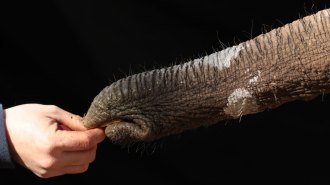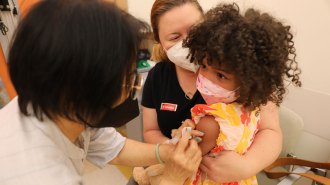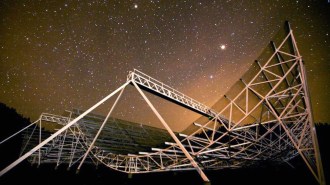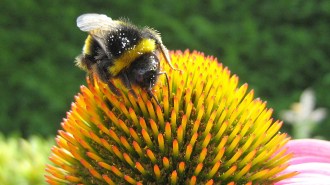News
-
 Life
LifeThe top side of an elephant’s trunk stretches more than the bottom
New research on elephant trunks could inspire different artificial skins for soft robots.
By Meghan Rosen -
 Astronomy
AstronomyClouds in the Milky Way’s plasma bubbles came from the starry disk — and far beyond
Gas clouds in the Fermi bubbles have a wide range of chemical compositions, suggesting some may have been ripped from other galaxies.
-
 Environment
EnvironmentUnderground heat pollution could be tapped to mitigate climate change
Data from thousands of groundwater well sites in Europe reveal that more than half of the locations possess usable underground heat.
By Nikk Ogasa -
 Health & Medicine
Health & MedicineHere are experts’ answers to questions about COVID-19 vaccines for little kids
Pediatricians recommend that parents vaccinate their kids, toddlers and babies against COVID-19 to protect them from coronavirus infection.
By Meghan Rosen -
 Astronomy
AstronomyA fast radio burst’s rapid, steady beat offers a clue to its cosmic origin
Amped-up neutron stars, pairs of magnetically entangled neutron stars or magnetar quakes could explain a three-second-long train of radio blips.
-
 Animals
AnimalsDo gophers farm roots? It’s not as clear as viral articles claim
Pocket gophers aerate and fertilize the soil in a practice that encourages rudimentary food production, researchers claim. But not everyone agrees.
-
 Tech
TechThis octopus-inspired glove helps humans grip slippery objects
The human hand, for all its deftness, is not great at grasping slippery stuff. A new glove aims to change that.
-
 Astronomy
AstronomyThe most distant rotating galaxy hails from 13.3 billion years ago
Astronomers have spotted a rotating galaxy whose light comes from just 500 million years after the Big Bang.
-
 Health & Medicine
Health & MedicineTwo pig hearts were successfully transplanted into brain-dead people
The transplants kept the patients’ blood flowing for three days and are an early step in figuring out if the procedure might work in living people.
-
 Environment
EnvironmentFlower shape and size impact bees’ chances of catching gut parasites
Bumblebees have higher chances of contracting a gut parasite from short, wide flowers than from blooms with other shapes, experiments show.
-
 Astronomy
AstronomyHere are the James Webb Space Telescope’s stunning first pictures
President Biden revealed the NASA telescope's image of ancient galaxies whose light has been traveling 13 billion years to reach us.
-
 Physics
PhysicsWiggling metal beams offer a new way to test gravity’s strength
A new experiment aims to get a better handle on “Big G,” the poorly measured gravitational constant.